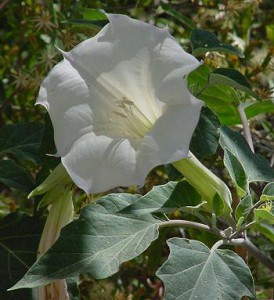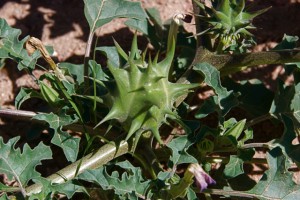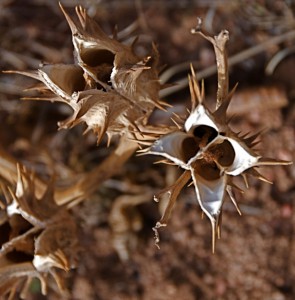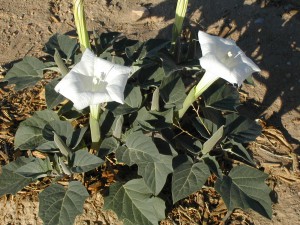Scientific name: Datura stramonium
 Family: Solanaceae
Family: Solanaceae
Common Name: Moonflower, Jimson Weed, Angel’s Trumpet
Article by Susan Bruneni
Datura stramonium is believed to have originated in the American Southwest, Mexico and South America, but other evidence suggests an Asian origin. The plant has been used medicinally throughout the world since ancient times. Zuni legends refer to Datura. It has been widely used in Chinese and Hindu medicinal practices as well.
Daturas range from bushy shrubs to trees. Deciduous leaves are pale green ranging up to 12 inches long, depending on the species. Flowers are fragrant, trumpet-shaped and range from white to pale yellow and pale orange. The flowering period is summer through fall, followed by production of thorny fruits (hence the common name Thornapple).
Seeds were sent from Chile to British horticultural writer Philip Miller in 1733. Most of the shipment had been destroyed by insects, but Miller managed to produce two plants with six-inch trumpet blooms. Those plants were Datura arborea, now re-classified into a closely related genus, Brugmansia arborea.

Green seed pod (Photo: Janice Tucker)
Many of the plants and trees that still grace legendary English gardens came from the New World. On January 10th Bonnie Joseph will explore the botanical fellowship between English horticulturists and North American colonists in her lecture, Brothers of the Spade. The lecture is part of SFBG’s annual Winter Lecture series.
One of the common American names for Datura is Jimson Weed, derived from the name Jamestown Weed. In 1676, British soldiers stationed at Jamestown ate a salad of Datura greens and were delusional for 11 days afterwards. (Some stories say the soldiers mistook the greens for something edible. Other accounts say they were intentionally misled by the antagonistic colonists.)
Leonora Curtin wrote extensively about Datura in Healing Herbs of the Upper Rio Grande. When Hernando Cortez entered the elaborate Aztec gardens he and his followers were amazed at their beauty and the variety of cures, including Datura, used to alleviate all bodily pains. The Aztec name toloatzin was later shortened to tolache, used for several distinct species of Datura and preferred by Curtin as the common name.

Seed pods open (Photo: Janice Tucker)
In her description of Datura, Curtin related the following Zuni legend: Long ago, she writes, when still dwelling in the underworld a boy and girl found a path up to the world of light and decorated their heads with garlands of Datura blossoms. They were bestowed by the plants with powers to make people sleep and see ghosts. When the children described their powers to the Twin Sons of the Sun Father the Divine Ones were alarmed and removed the children from the earth. Datura blossoms grow at the spot where they vanished. Curtin said in her writings that Zunis still attribute Datura with the powers to induce sleep and see ghosts, especially when used by rain priests to call the rain.
Browsing animals usually do not like the taste and avoid the toxicity of the plant. Children are particularly vulnerable because they are attracted by the sweetish taste of the half-ripe seeds.

Photo: Carl Troy
In early times, Datura was considered an aid to the incantation of witches, and during the time of the witch and wizard mania in England, it was unlucky for anyone to grow it in a garden. If Datura appears in cultivated crop areas, farmers say it is best to remove it completely to avoid any contamination. Although the seeds and leaves are considered the most toxic, all parts of the plant should be avoided. Some gardeners report a mild numbness in their fingers when in contact with the plant.


